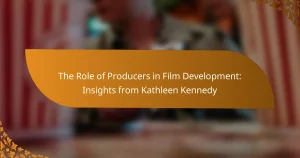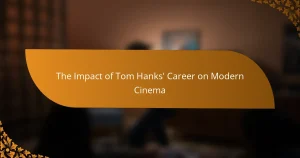![]()
What are the Iconic Collaborations between Martin Scorsese and Robert De Niro?
Martin Scorsese and Robert De Niro have collaborated on several iconic films. Their partnership includes “Taxi Driver,” released in 1976, which explores urban alienation. “Raging Bull,” from 1980, showcases De Niro’s transformation into boxer Jake LaMotta. “Goodfellas,” released in 1990, is a classic crime film that depicts mob life. “Cape Fear,” from 1991, features De Niro as a menacing antagonist. “Casino,” released in 1995, examines the complexities of the Las Vegas casino scene. Each film has received critical acclaim and contributed significantly to cinema history. Their collaborations are noted for powerful performances and innovative storytelling.
How did Martin Scorsese and Robert De Niro first collaborate?
Martin Scorsese and Robert De Niro first collaborated on the film “Mean Streets” in 1973. This marked the beginning of a long and successful partnership. Scorsese directed the film, which focused on the lives of small-time criminals in New York City. De Niro played the character Johnny Boy, showcasing his talent in a pivotal role. The film was critical in establishing both Scorsese and De Niro in the film industry. “Mean Streets” is often regarded as a defining work in American cinema. Their collaboration set the stage for numerous future projects together.
What was the significance of their first film together?
Their first film together, “Mean Streets,” is significant as it marked the beginning of a legendary collaboration between Martin Scorsese and Robert De Niro. Released in 1973, the film showcased their unique storytelling approach and character development. It introduced De Niro’s raw talent and Scorsese’s innovative directing style. The film also highlighted themes of crime, morality, and redemption, setting a precedent for their future projects. “Mean Streets” was pivotal in establishing Scorsese’s reputation as a filmmaker. It laid the groundwork for their subsequent collaborations, which would redefine American cinema. The film’s impact is evident in its lasting influence on the gangster genre and its critical acclaim.
How did their collaboration evolve over time?
Martin Scorsese and Robert De Niro’s collaboration evolved significantly over several decades. They first worked together on “Mean Streets” in 1973, establishing a strong creative partnership. This initial success led to subsequent films, including “Taxi Driver” in 1976, which showcased De Niro’s range and Scorsese’s directorial vision. Their collaboration deepened with “Raging Bull” in 1980, where De Niro’s transformative performance earned him an Academy Award.
In the 1990s, they reunited for “Goodfellas,” further solidifying their status as a filmmaking duo. Their partnership continued with “Casino” in 1995, demonstrating their ability to tackle complex narratives. Over time, Scorsese and De Niro’s collaboration became characterized by mutual trust and artistic exploration. They explored various themes, such as crime, identity, and redemption, reflecting their growth as artists.
Their continued collaboration, including projects like “The Irishman” in 2019, showcases their enduring connection and ability to adapt to changing cinematic landscapes. This evolution signifies not only their personal growth but also their impact on American cinema.
What themes are prevalent in their collaborations?
Recurring themes in the collaborations between Martin Scorsese and Robert De Niro include crime, redemption, and the complexities of masculinity. Their films often explore the criminal underworld, showcasing characters involved in organized crime. Redemption arcs are prevalent, where characters seek forgiveness or a new path. The theme of masculinity is examined through the struggles and vulnerabilities of male protagonists. These themes are evident in films like “Taxi Driver,” “Goodfellas,” and “Raging Bull.” Each film delves into the psychological depth of its characters, reflecting Scorsese’s directorial style and De Niro’s intense performances. The combination of these themes creates a rich narrative landscape that defines their iconic collaborations.
How do these themes reflect the characters portrayed by De Niro?
The themes in Scorsese’s films reflect De Niro’s characters through their exploration of identity, morality, and personal conflict. De Niro often portrays complex individuals grappling with their inner demons. For instance, in “Taxi Driver,” the theme of isolation is evident in Travis Bickle’s descent into madness. This reflects De Niro’s ability to embody characters facing psychological turmoil. Similarly, in “Raging Bull,” themes of violence and redemption highlight the struggle of Jake LaMotta with his own flaws. These themes underscore the multifaceted nature of De Niro’s performances. Each character he portrays reveals deeper societal issues, such as alienation and the quest for meaning. De Niro’s nuanced performances bring these themes to life, making them resonate with audiences.
What stylistic choices does Scorsese use to highlight these themes?
Scorsese employs various stylistic choices to highlight themes in his films. He frequently uses dynamic camera movements to create a sense of urgency. For example, tracking shots enhance the intensity of pivotal scenes. Scorsese also utilizes a distinct color palette to evoke emotional responses. The use of contrasting colors often emphasizes moral dilemmas faced by characters. Additionally, he incorporates period-specific music to establish atmosphere and context. The soundtrack often reflects the cultural background of the narrative. Scorsese’s editing style features rapid cuts to build tension and maintain viewer engagement. This technique is evident in films like “Goodfellas,” where pacing mirrors the characters’ chaotic lives. Overall, these stylistic choices effectively underscore the complex themes present in his work.
What impact did their collaborations have on cinema?
The collaborations between Martin Scorsese and Robert De Niro significantly impacted cinema. Their partnership redefined the crime genre, showcasing complex characters and narratives. Films like “Taxi Driver” and “Goodfellas” became cultural touchstones. These movies explored themes of identity, morality, and violence in innovative ways. Their work influenced a generation of filmmakers and actors. Scorsese’s directorial style and De Niro’s performances set new standards in storytelling. The duo’s collaborations earned critical acclaim and numerous awards, solidifying their legacy in film history. Their impact continues to resonate in contemporary cinema.
How did their films influence the gangster genre?
Martin Scorsese and Robert De Niro significantly influenced the gangster genre through their collaborative films. Their works, such as “Taxi Driver” and “Goodfellas,” redefined the portrayal of crime and morality. Scorsese’s direction emphasized character complexity and psychological depth. De Niro’s performances brought intense realism to the characters he portrayed. Their films often depicted the consequences of a gangster lifestyle, challenging romanticized notions of crime. The use of innovative storytelling techniques, such as non-linear narratives, set new standards in filmmaking. Additionally, their exploration of themes like loyalty and betrayal resonated deeply within the genre. This collaboration has left a lasting impact on how gangster stories are told in cinema.
What awards and recognitions did their collaborations receive?
Their collaborations received numerous prestigious awards and recognitions. Notably, the film “Taxi Driver” won the Palme d’Or at the 1976 Cannes Film Festival. “Raging Bull” earned two Academy Awards, including Best Actor for De Niro. “Goodfellas” was nominated for six Academy Awards, winning one for Best Supporting Actor. Additionally, the AFI awarded “Goodfellas” the title of one of the 100 greatest American films. Their work together has also been recognized with various Golden Globe nominations and wins, highlighting their impactful contributions to cinema.
What are the key films in their collaboration history?
The key films in the collaboration history of Martin Scorsese and Robert De Niro include “Mean Streets,” “Taxi Driver,” “Raging Bull,” “Goodfellas,” “Casino,” and “The Irishman.” “Mean Streets” marked their first collaboration in 1973, establishing their partnership. “Taxi Driver,” released in 1976, earned De Niro an Academy Award nomination. “Raging Bull,” from 1980, is considered one of the greatest films of all time and won two Oscars. “Goodfellas,” released in 1990, is a critically acclaimed crime film that showcases their signature style. “Casino,” from 1995, explores the Las Vegas mafia scene. “The Irishman,” released in 2019, reunites them for a reflective narrative on aging and regret. Each film highlights their artistic synergy and has significantly impacted cinema.
What makes “Taxi Driver” a landmark film in their partnership?
“Taxi Driver” is a landmark film in the partnership of Martin Scorsese and Robert De Niro due to its groundbreaking exploration of urban alienation. The film features De Niro as Travis Bickle, a mentally unstable Vietnam War veteran. Scorsese’s direction amplifies the film’s psychological depth and social commentary. The collaboration resulted in a unique portrayal of loneliness and moral decay in 1970s New York City. “Taxi Driver” received the Palme d’Or at the 1976 Cannes Film Festival, solidifying its critical acclaim. This film marked a significant moment in both their careers, showcasing their ability to tackle complex themes. The iconic line “You talkin’ to me?” became emblematic of De Niro’s character and the film’s impact on popular culture. Their partnership in “Taxi Driver” set the stage for future collaborations, influencing the landscape of American cinema.
How did “Raging Bull” redefine biographical storytelling?
“Raging Bull” redefined biographical storytelling by emphasizing raw emotional truth over conventional narrative structures. The film presented a gritty portrayal of boxer Jake LaMotta’s life, showcasing his inner turmoil and personal demons. It utilized innovative techniques, such as nonlinear storytelling and stark black-and-white cinematography. These choices highlighted the complexity of LaMotta’s character, diverging from typical heroic biopics. The film’s brutal realism and psychological depth influenced subsequent biographical films. Critics noted its impact on how personal struggles are depicted in cinema. “Raging Bull” remains a benchmark for authenticity in biographical storytelling.
How do Scorsese and De Niro’s personal dynamics influence their work?
Scorsese and De Niro’s personal dynamics significantly enhance their collaborative work. Their long-standing friendship fosters trust and creative freedom. This bond allows them to explore complex characters and themes. De Niro often immerses himself deeply into roles, influenced by Scorsese’s direction. Their shared vision leads to iconic films like “Taxi Driver” and “Raging Bull.” Scorsese’s ability to challenge De Niro results in powerful performances. The duo’s synergy is evident in their meticulous attention to detail. This dynamic has shaped modern cinema, setting a benchmark for actor-director relationships.
What insights can be drawn from their interviews about each other?
Insights from interviews between Martin Scorsese and Robert De Niro reveal a deep mutual respect. Scorsese often highlights De Niro’s transformative acting skills. De Niro admires Scorsese’s vision and storytelling ability. They both emphasize the importance of collaboration in their creative process. Their discussions often reflect a shared commitment to authenticity in filmmaking. De Niro’s dedication to character preparation is frequently acknowledged by Scorsese. Scorsese’s innovative directing style inspires De Niro’s performances. Their interviews showcase a partnership built on trust and artistic synergy.
How does their mutual respect shape the performances in their films?
Mutual respect between Martin Scorsese and Robert De Niro enhances their film performances significantly. This respect fosters a collaborative environment. De Niro feels empowered to explore complex characters. Scorsese trusts De Niro’s instincts, allowing for improvisation. Their synergy leads to authentic portrayals, as seen in “Taxi Driver.” In this film, De Niro’s nuanced performance reflects their deep understanding of each other. This dynamic results in greater emotional depth in their storytelling. Their mutual admiration is evident in their consistent collaboration over decades.
What lessons can filmmakers learn from Scorsese and De Niro’s collaboration?
Filmmakers can learn the importance of collaboration and trust from Scorsese and De Niro’s partnership. Their synergy resulted in iconic films like “Taxi Driver” and “Raging Bull.” Scorsese’s direction and De Niro’s performances created compelling narratives. This collaboration demonstrates the value of shared vision in filmmaking. Filmmakers should prioritize strong communication and mutual respect. Scorsese and De Niro’s work emphasizes character development and storytelling depth. Their films often explore complex themes, showcasing the power of character-driven narratives. This partnership illustrates how consistent collaboration can lead to artistic innovation and critical acclaim.
How can directors effectively work with actors to create memorable performances?
Directors can effectively work with actors by fostering open communication. This involves discussing character motivations and emotional arcs. Regular rehearsals allow actors to explore their roles deeply. Providing constructive feedback helps refine performances. Directors should create a safe environment for actors to take risks. Collaborating on the script can enhance authenticity. Utilizing improvisation can lead to unexpected, memorable moments. Historical examples show that directors like Martin Scorsese achieve this with actors like Robert De Niro, resulting in iconic performances.
What best practices can be derived from their filmmaking process?
Best practices derived from the filmmaking process of Martin Scorsese and Robert De Niro include strong collaboration and open communication. Their partnership exemplifies the importance of shared vision and mutual respect. Scorsese often allows De Niro to contribute creatively, enhancing character development. This collaboration fosters innovation and authenticity in storytelling.
They prioritize thorough research and preparation before filming. This approach ensures that the narrative is well-structured and grounded in reality. Scorsese’s meticulous attention to detail in cinematography and editing is another best practice that enhances the film’s impact.
Additionally, they embrace experimentation with various styles and genres. This willingness to take risks can lead to unique storytelling methods. Their focus on character-driven narratives allows for deeper emotional connections with the audience.
Finally, Scorsese and De Niro emphasize the importance of revisiting themes and motifs across different films. This consistency helps to build a recognizable artistic signature. Collectively, these practices contribute to their successful and influential filmmaking legacy.
The main entity of the article is the collaboration between Martin Scorsese and Robert De Niro. The article analyzes their iconic partnership through key films such as “Mean Streets,” “Taxi Driver,” “Raging Bull,” and “Goodfellas,” highlighting significant themes like crime, redemption, and masculinity. It explores how their collaboration evolved over time, the stylistic choices made by Scorsese, and the impact of their films on cinema, particularly within the gangster genre. Additionally, it examines the personal dynamics between Scorsese and De Niro and the lessons filmmakers can learn from their successful working relationship.


